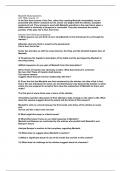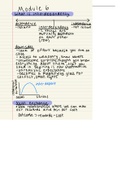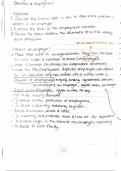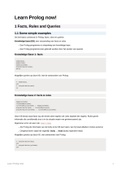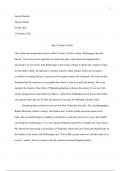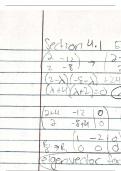Problem 4: Personality Traits
Trait: a predisposition that tends to make us behave in a certain way.
Trait State
predisposition Environmental cue
Stable and enduring Temporary
Continuous, dimensional, measurable Inner entities from observed behaviour
e.g. aggression, calmness, patience, e.g. (emotion + mood) anxiety,
depression, fatigue, arousal, curiosity
The Trait Theory by Gordon W. Allport 1897-1967
Since traits are continuous, that automatically makes them dimensional meaning they are measurable
characteristics. One is not just extrovert or just introvert; these traits can be put on a continuous graph
i.e. Normal Distribution. The Trait Theory simply explains that personality dimensions can be used to
summarise the fundamental psychological differences between individuals.
• Traits are the basic units of personality
• Traits are based in the nervous system (hence predispositional)
• Traits imply the consistency of behaviour while the situation implies the variability of
behaviour−both are important to understand behaviour.
• A trait is not endorsed/expressed in all situations
• A trait expresses what a person generally does over many situations not merely one situation
• Traits represent generalised personality dispositions that account for regularities in the
functioning of a person across situations & over time.
3 Properties of traits
Frequency Intensity Range
, Types of traits:
Cardinal traits: They define and dominate one’s behaviour. This disposition is very generalised, rare
and outstanding that we can trace every act to its influence. e.g Mother Teresa= altruism.
Central traits: Meaningful traits. They cover a more limited range of situations than cardinal traits.
(e.g. honesty, kindness, assertiveness).
Super traits: superset of another trait, does not have inheritance.
Narrow traits/Component traits: components of broad traits, that are consistent over time and
across situations. e.g optimism
Habitual traits: Part of our routine, expressed often.
Specific traits: unique traits
Constitutional traits: genetics, nature
Environmental traits: Shaped by the environment, nurture
Surface traits: (From the Factor Analytic theory of Cattell 1905-1998) Superficial traits. Can be
observed, intercorrelated.
Source traits: (From the Factor Analytic theory of Cattell 1905-1998) Internal psychological
structures that are the underlying cause of observed intercorrelations among surface traits. They can
be revealed through factor analysis and are divided into 3 branches:
I. Ability traits: Skills and abilities such as intelligence.
II. Temperament traits: Emotional and energetic reactivity. Whether someone responds in a
calm way, or emotional, or quick etc.
III. Dynamic traits: Strive and motivation.
Allport’s views: (those are NOT mutually exclusive concepts)
Nomothetic: (“Nomos” in Greek means law)- traits exist in the same way in every person, hence you
cannot compare people with each other unless a trait has the same meaning for everyone. Key
word: people CAN be compared.
Idiographic: (opposite to nomothetic)- each person is unique hence those traits are individualised
that prevents us from comparing people together. Key word: people CANNOT be compared.
Important definitions:
Personality coherence: (Coherence=harmony) Same personality trait, but different manifestations
over time. For example, when someone cannot go sky diving because they are old, they express this
personality trait through a less extreme activity.
Functional autonomy: When motives become independent from earlier drives. Usually happens in
adulthood. e.g choosing an occupation for one reason such as job security and then remaining in
that occupation for other motives such as job pleasure.
Ways of measuring traits
Use of language
Lexical criterion: the more words there are for a trait, the more important that trait is. This is
empirical.
Trait: a predisposition that tends to make us behave in a certain way.
Trait State
predisposition Environmental cue
Stable and enduring Temporary
Continuous, dimensional, measurable Inner entities from observed behaviour
e.g. aggression, calmness, patience, e.g. (emotion + mood) anxiety,
depression, fatigue, arousal, curiosity
The Trait Theory by Gordon W. Allport 1897-1967
Since traits are continuous, that automatically makes them dimensional meaning they are measurable
characteristics. One is not just extrovert or just introvert; these traits can be put on a continuous graph
i.e. Normal Distribution. The Trait Theory simply explains that personality dimensions can be used to
summarise the fundamental psychological differences between individuals.
• Traits are the basic units of personality
• Traits are based in the nervous system (hence predispositional)
• Traits imply the consistency of behaviour while the situation implies the variability of
behaviour−both are important to understand behaviour.
• A trait is not endorsed/expressed in all situations
• A trait expresses what a person generally does over many situations not merely one situation
• Traits represent generalised personality dispositions that account for regularities in the
functioning of a person across situations & over time.
3 Properties of traits
Frequency Intensity Range
, Types of traits:
Cardinal traits: They define and dominate one’s behaviour. This disposition is very generalised, rare
and outstanding that we can trace every act to its influence. e.g Mother Teresa= altruism.
Central traits: Meaningful traits. They cover a more limited range of situations than cardinal traits.
(e.g. honesty, kindness, assertiveness).
Super traits: superset of another trait, does not have inheritance.
Narrow traits/Component traits: components of broad traits, that are consistent over time and
across situations. e.g optimism
Habitual traits: Part of our routine, expressed often.
Specific traits: unique traits
Constitutional traits: genetics, nature
Environmental traits: Shaped by the environment, nurture
Surface traits: (From the Factor Analytic theory of Cattell 1905-1998) Superficial traits. Can be
observed, intercorrelated.
Source traits: (From the Factor Analytic theory of Cattell 1905-1998) Internal psychological
structures that are the underlying cause of observed intercorrelations among surface traits. They can
be revealed through factor analysis and are divided into 3 branches:
I. Ability traits: Skills and abilities such as intelligence.
II. Temperament traits: Emotional and energetic reactivity. Whether someone responds in a
calm way, or emotional, or quick etc.
III. Dynamic traits: Strive and motivation.
Allport’s views: (those are NOT mutually exclusive concepts)
Nomothetic: (“Nomos” in Greek means law)- traits exist in the same way in every person, hence you
cannot compare people with each other unless a trait has the same meaning for everyone. Key
word: people CAN be compared.
Idiographic: (opposite to nomothetic)- each person is unique hence those traits are individualised
that prevents us from comparing people together. Key word: people CANNOT be compared.
Important definitions:
Personality coherence: (Coherence=harmony) Same personality trait, but different manifestations
over time. For example, when someone cannot go sky diving because they are old, they express this
personality trait through a less extreme activity.
Functional autonomy: When motives become independent from earlier drives. Usually happens in
adulthood. e.g choosing an occupation for one reason such as job security and then remaining in
that occupation for other motives such as job pleasure.
Ways of measuring traits
Use of language
Lexical criterion: the more words there are for a trait, the more important that trait is. This is
empirical.

